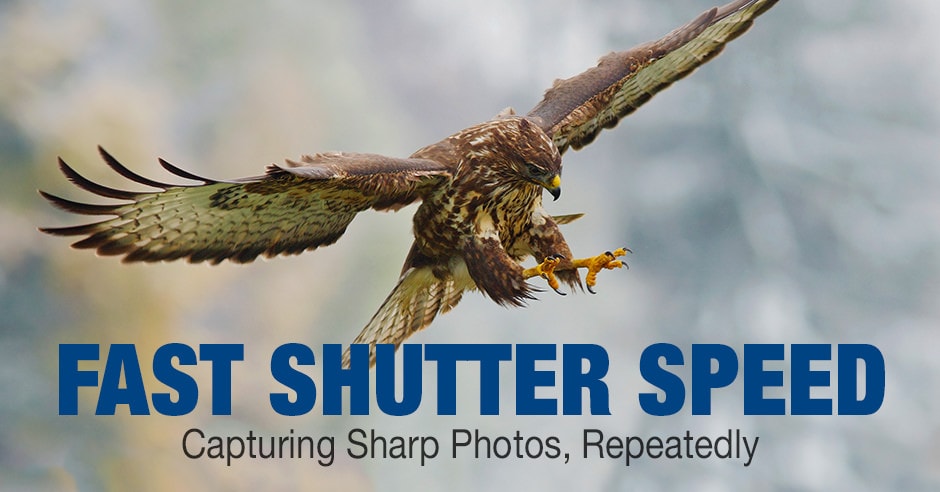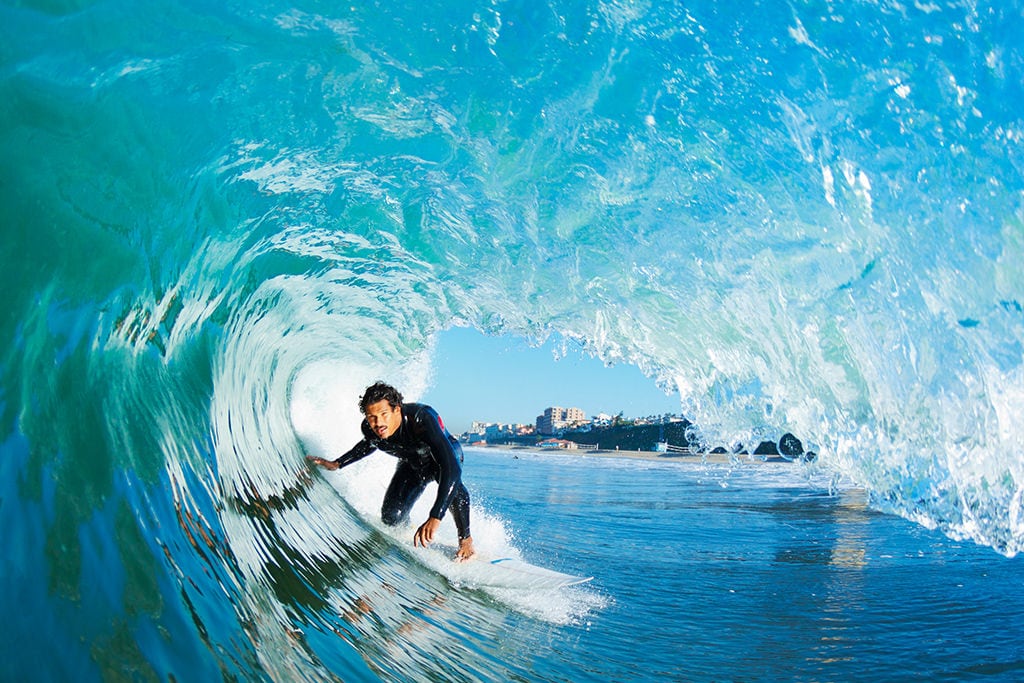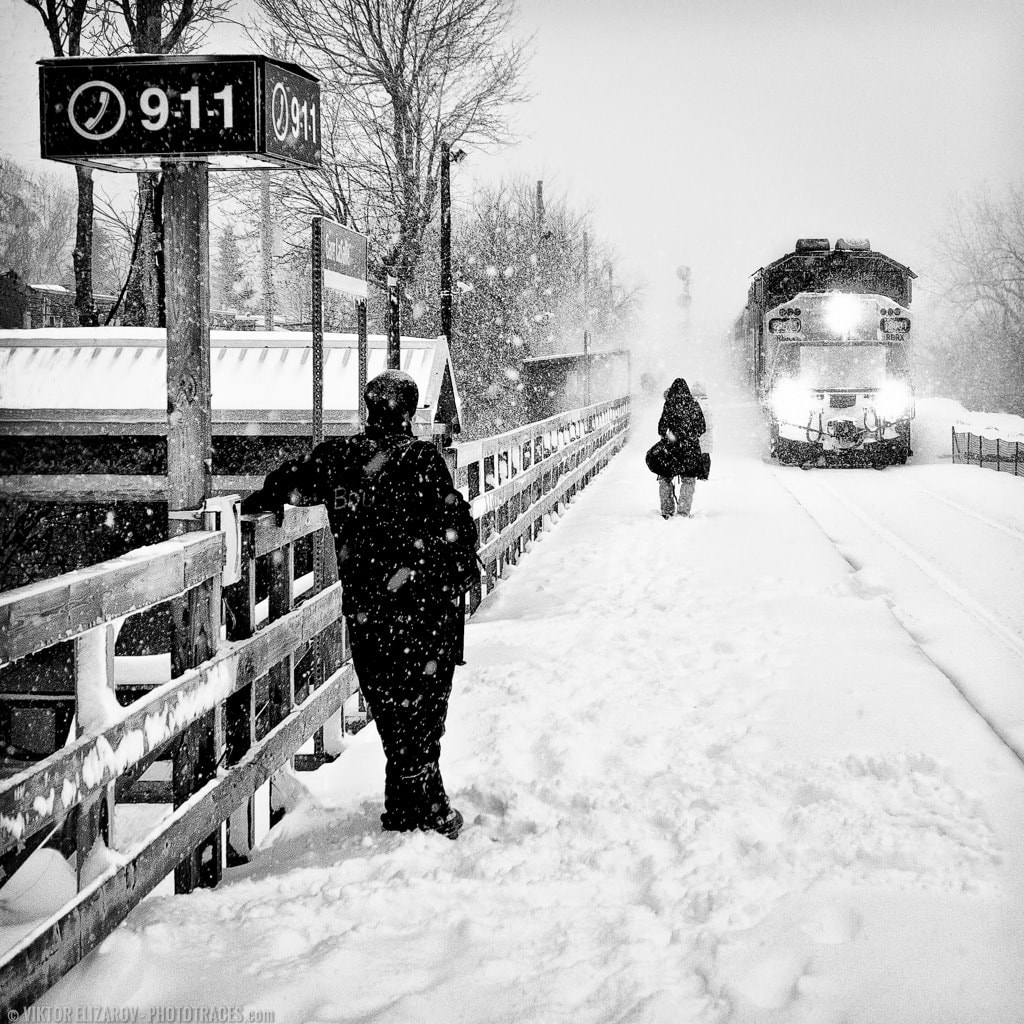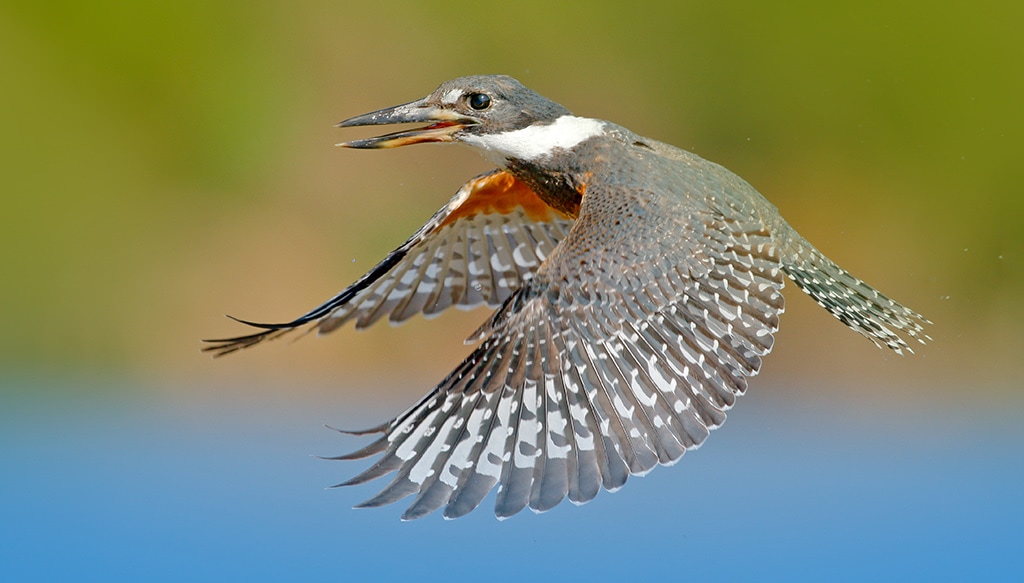Do you find the concept of using a fast shutter speed bewildering? You’re not alone. Determining the right shutter speed can be a challenging task for many photographers, particularly when they’re out in the field faced with the need to make quick decisions.

But fear not, because, with the right guidance, shutter speed becomes surprisingly straightforward. This article is your key to unraveling the secrets of fast shutter speed, making them accessible to photographers of all levels.
Let’s get started.
What Is a Fast Shutter Speed?
Fast shutter speeds are typically defined as those with a relatively high fraction of a second, such as 1/400s or 1/500s. These high-speed settings are essential when photographing fast-paced subjects, whether it’s sports, wildlife, or any scenario where you want to freeze split-second movements and ensure that they appear crisp and clear in the photograph.
The choice of a fast shutter speed depends on the speed of the subject and the level of action involved. Using a fast shutter speed allows you to capture these high-speed moments with precision and clarity, making it a fundamental tool in action photography.
What is Shutter Speed?
Shutter speed is a fundamental aspect of photography that plays a crucial role in capturing images. At its core, it involves controlling the duration for which the camera’s sensor or film is exposed to light when you take a photograph. This duration is determined by the opening and closing of the camera’s shutter mechanism, and it has a profound impact on the final image.
Mechanical Shutter
The mechanical shutter is a key component in most traditional cameras. It typically consists of two curtains or blades. When you press the shutter button, the first curtain opens, exposing the camera’s sensor to incoming light. Once the desired exposure time has elapsed, the second curtain closes, blocking further light from reaching the sensor.
Shutter Speed and Exposure
Shutter speed is directly connected to the exposure of an image. In photography, exposure refers to the amount of light that strikes the camera’s sensor. The relationship is straightforward: a longer shutter speed results in a greater amount of light hitting the sensor, leading to a brighter image. Conversely, a shorter shutter speed allows less light to reach the sensor, resulting in a darker image.
Shutter speed is measured in seconds and fractions of a second, with values such as
1/2s, 1s, 1/20s, 1/200s, 1/500s, 1/1000s, 1/4000s, etc.
When adjusting shutter speed, each change represents a significant alteration in the exposure value.
By doubling or halving the shutter speed you are changing the exposure value by a factor of 2 or 1-stop, significantly impacting the overall brightness of the image.
Capturing Motion with Shutter Speed
Another key function of shutter speed is to control the way motion is captured in a photograph.
A fast shutter speed, such as 1/1000s or 1/500s, freezes fast-moving subjects in action photography, ensuring that they appear sharp and without motion blur.
On the other hand, a slower shutter speed, like 1/20s or 1s, can introduce motion blur and convey a sense of movement in the image. This technique is often used for creative purposes, such as capturing the flow of water or the streaking lights of moving vehicles.
Understanding how to effectively use shutter speed is essential for photographers, as it allows them to control exposure, freeze or convey motion, and bring their creative vision to life.

When to Use Fast Shutter Speeds
There’s one main time when you’ll want to use a fast shutter speed:
When you need to freeze motion.
This can happen in a number of scenarios:
1. Action Sport Photography
If you’re shooting action sports, you’ll undoubtedly need a fast shutter speed. The precise value depends on the sport, but I recommend working with a shutter speed of at least 1/1000s for fast moving people, and even faster (e.g., 1/2000s) when photographing people on vehicles such as mountain bikes.
See also: Wildlife Photography Equipment
Freezing fast-moving water and the surfer with a fast shutter speed

2. Wildlife Photography
If you’re shooting wildlife, you have a few different shutter speed options, depending on your subject. If the wildlife is moving slowly (or not moving at all), then you can get away with shutter speeds of 1/100s to 1/400s.
See also: Tutorials for Wildlife Photography
But if the wildlife is moving quickly and you want to freeze it in motion, I recommend a shutter speed of at least 1/1000s, and probably 1/2000s for anything leaping, falling, or in flight.
Bird in flight requires a shutter speed of 1/1000s or faster.

3. Macro Photography (Water Droplets)
If you want to photograph water droplets, you’ll be working at high magnifications–which means you need a correspondingly high shutter speed to compensate.
See also: Best Macro Lenses for Nikon
That’s why I recommend using a shutter speed of around 1/1000s for photographing water droplets (just to be safe).

4. Street Photography
If you’re photographing street scenes, I recommend using a shutter speed between 1/400s and 1/1000s. And if you’re photographing street scenes with fast-moving cars, trains, busses then I recommend an even higher shutter speed of around 1/1600s or 1/2000s. This will ensure you freeze the cars, without ending up with any blur at all.
Related: 10 Famous Street Photographers

5. Family Photography (Running Kids)
When it comes to photographing families, you have to be careful. If your kids are running around, you might end up with a blurry photo–which absolutely nobody will appreciate.
So you use fast shutter speed.
1/1000s is a good starting point, and will generally ensure the kids are completely frozen.
Reasons for Using Fast Shutter Speed
Freezing Fast Action
In situations where subjects are in rapid motion, such as athletes in action sports or wildlife on the move, a shutter speed of 1/400s to 1/500s becomes indispensable. It allows you to freeze the action, capturing the subject in clear detail without any motion blur. This is especially critical for sports photographers who need to capture that split-second touchdown or a wildlife photographer snapping a bird in flight.

Reducing Camera Shake
A faster shutter speed not only freezes the subject but also minimizes the impact of camera shake. When shooting at slower speeds, even the slightest hand tremors or vibrations can result in blurry images. By increasing your shutter speed, you ensure your photos remain sharp and shake-free.
Versatility in Bright Lighting Conditions
Fast shutter speeds offer versatility, allowing you to work in various lighting conditions. They are especially beneficial in situations where you need to counteract the effects of bright sunlight. By selecting a faster shutter speed, you can maintain proper exposure while still capturing the action.
Creative Control
Using shutter speeds in the 1/400s to 1/500s range can also enable you to experiment with creative photography techniques. For instance, you can capture unique water droplet splashes, freeze motion in street photography, or create stunning, high-speed macro shots.
How to Use Fast Shutter Speed
To harness the power of a fast shutter speed effectively, you must make the necessary adjustments to your camera settings. These adjustments are vital in ensuring that you capture those split-second moments with precision and clarity. Here’s a step-by-step guide on how to use fast shutter speed:
1. Shutter Priority Shooting Mode (S/Tv)
Begin by setting your camera to Shutter Priority mode, often denoted as “S” (Nikon) or “Tv” (Canon). This mode allows you to control the shutter speed while the camera takes care of the aperture. By selecting a fast shutter speed here, you ensure that your camera prioritizes capturing quick movements.
2. Continuous Autofocus (AF-C)
Switch your camera’s autofocus mode to Continuous Autofocus (AF-C) or AI Servo (Canon). This setting enables your camera to constantly adjust the focus as the subject moves, ensuring that your fast-moving subject remains sharp and in focus.

3. Dynamic Area AF Mode
Use the Dynamic Area AF mode to allow your camera to track moving subjects across the frame. This mode is particularly useful for action sports or any scenario where your subject is in motion. It helps maintain focus on the subject even as it moves within the frame.
4. Continuous (Burst) Drive Mode
Take advantage of the Continuous or Burst Drive Mode. This mode allows you to capture a rapid series of shots in quick succession. It’s perfect for action photography because it increases the chances of capturing that perfect moment during fast-paced action.
5. File Format
While using RAW format generally provides better image quality and a wider dynamic range, in action sports photography, it’s common to switch to JPEG format. JPEG vs RAW files are smaller and allow for longer bursts before the camera’s buffer fills up, making sure you don’t miss crucial moments.
6. Memory Card Speed
Opt for the fastest memory card your camera supports. This choice ensures that your burst images are transferred quickly from the camera’s buffer to the memory card, reducing downtime between bursts.
7. ISO Settings:
Given the fast shutter speed limits the amount of light reaching the sensor, you may need to adjust the ISO settings to balance the exposure. Increase the ISO setting as needed to compensate for the reduced light. However, be cautious not to underexpose the photos, as this can result in a higher level of noise, especially at high ISO settings.
By following these steps and adjusting your camera settings accordingly, you’ll be well-prepared to make the most of a fast shutter speed, capturing action-packed moments with precision and clarity, whether you’re shooting sports, wildlife, or any fast-moving subject.

Fast Shutter Speed: FAQs
What is the Minimum Shutter Speed?
Minimum shutter speed refers to the slowest shutter speed at which a camera can operate while still producing a properly exposed image under specific lighting conditions. It is an important concept in photography because it determines the length of time the camera’s sensor or film is exposed to light.
Now, while most cameras allow you to shoot with a shutter speed of 30s or faster, the minimum shutter speed varies from camera to camera.
For instance, a consumer camera like the Canon T7i/800D has a minimum shutter speed of 1/4000s. But a professional-grade sports camera such as the Canon 1D X Mark II allows shutter speeds of up to 1/8000s.
Photographers need to know their camera’s minimum shutter speed and consider this factor along with other settings like aperture and ISO to achieve the desired results in different lighting conditions and shooting scenarios.
What is the Difference Between Fast Shutter Speed vs Slow Shutter Speed?
The distinction between a fast shutter speed and a slow shutter speed lies in the duration for which the camera’s sensor or film is exposed to light when taking a photograph. Here are the key distinctions between the two:
Fast Shutter Speed
- Brief Exposure Time: Fast shutter speeds result in a shorter exposure time, meaning that the sensor or film is exposed to light for only a brief moment.
- Freezing Motion: Faster shutter speeds are typically used to freeze fast-moving subjects or capture action with precision. They are essential for sports photography, wildlife photography, and any situation where you want to capture a subject in motion without motion blur.
- Reduced Light: Because of the short exposure time, less light reaches the camera’s sensor. To maintain proper exposure, a wider aperture or a higher ISO setting is often required when using faster shutter speeds.

Slow Shutter Speed
- Extended Exposure Time: Slow shutter speeds result in a longer exposure time, allowing the sensor or film to be exposed to light for an extended period.
- Motion Blur: Slow shutter speeds are used to intentionally introduce motion blur into photographs. This effect can be creatively employed for capturing the flow of water, creating light trails from moving vehicles, or conveying a sense of motion in a scene.
- Increased Light: Owing to the lengthier exposure time, more light reaches the camera’s sensor. This is particularly advantageous in low-light conditions or when aiming to capture the ambiance of a scene with a protracted exposure.
- Creative Possibilities: Slow shutter speeds open the door to creative photography techniques. They empower you to craft velvety-smooth waterfalls, capture celestial star trails, or evoke a feeling of movement in nocturnal cityscapes.

The choice between using a faster or slower shutter speed depends on your creative objectives and the specific demands of your photography.
Faster shutter speeds excel at arresting dynamic action and ensuring the sharpness of swiftly moving subjects, while slower shutter speeds offer a canvas for artistic exploration and the infusion of motion blur into your compositions.
Fast Shutter Speed | Final Thoughts
Hopefully, you now have a sense of fast shutter speed, their purpose, and how to deal with them in the field.
After all, choosing the right shutter speed is one of the main keys to a sharp image.
So make sure you think about your shutter speed–and start shooting!
Some amazing photos await.

